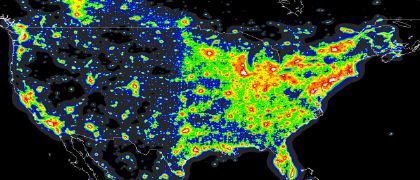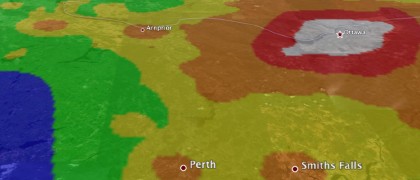Light Pollution Maps
Light pollution is the bane of astronomers worldwide. Cities generate so much light that their glow can be seen from great distances; that sky glow interferes with astronomical observations, reducing what can be seen, both with the naked eye and through telescopes. It’s bad enough to close observatories.
There are campaigns against light pollution (see, for example, the International Dark-Sky Association and this New Yorker article from last August) not only on astronomical grounds, but also on environmental (wildlife disruptions, such as migrating birds and nesting sea turtles) and energy conservation grounds. What can you do? Turn off unnecessary nighttime lights and use fixtures that focus all the light downwards, where it’s needed, rather than upwards, where it’s wasted.

Meanwhile, astronomers look to light-pollution maps, both to demonstrate the extent of the problem and to find decent sites from which to observe. Maps are available online at The Night Sky in the World website. There are world and continental maps of artificial night-sky brightness, maps depicting the growth of light pollution, and more. If there’s a way to express the loss of night-sky visibility, whether it’s by limiting magnitude or number of stars visible, it’s probably there, though the focus is more on Europe than on North America.

The light pollution map can be brought closer to Earth, so to speak, through the Clear Sky Clocks: these web pages measure astronomical observing conditions — not just light pollution, but cloud cover and atmospheric turbulence — at nearly two thousand North American sites. Each observing site’s page has a light-pollution page; here’s one for a site near where I live: there’s a small map showing its location relative to the light pollution map, a legend explaining the colours, and a link to a KML file for displaying it in Google Earth. If my neck of the woods is any indication (above), I could be doing better. Via Ogle Earth.
I think I need to move to Australia.

Comments
blog comments powered by Disqus